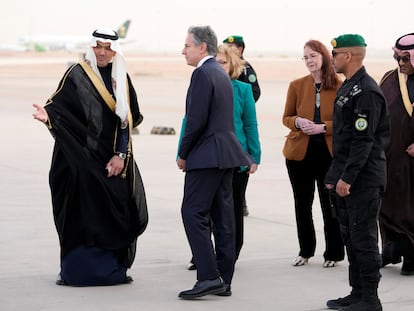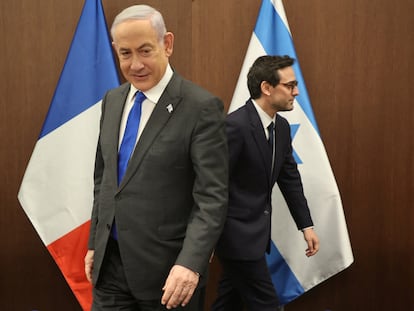Netanyahu rejects 135-day Gaza ceasefire proposal: ‘Surrendering to Hamas will just invite another massacre’
The Israeli prime minister described as ‘delusional’ the demands of the Islamist movement in exchange for the release of the 136 hostages in the Strip. ‘A lot of work remains to be done,’ said U.S. Secretary of State Antony Blinken
Israeli Prime Minister Benjamin Netanyahu rejected on Wednesday Hamas’ terms for handing over the 136 hostages still in Gaza: 135 days of ceasefire, the release of up to 1,500 Palestinian prisoners, the withdrawal of Israeli troops from the entire Palestinian enclave, the entry of more humanitarian aid, the beginning of the reconstruction of the territory, and the indirect negotiation of the definitive end of the war. “Surrendering to Hamas’ delusional demands that we heard now not only won’t lead to freeing the captives, it will just invite another massacre” like the one on October 7, Netanyahu said in a nationally televised news conference. “We are on the way to an absolute victory. There is no other solution,” he added. That was his response to the proposal that the Islamist movement handed over to mediators on Tuesday and that U.S. Secretary of State Antony Blinken discussed this Wednesday with Israeli leaders during his visit to the region.
According to a draft of the proposal consulted by Reuters, the pact would be implemented in three 45-day phases. In the first, Hamas would hand over women, men aged under 19 and over 50, and the sick, in exchange for the release of Palestinian women and children at a rate to be set later. The Israeli army, which is currently operating intensively in Khan Younis, Gaza’s second-largest city, would have to withdraw from urban areas. Then would come the turn of the male hostages and Israeli troops would have to leave all parts of Gaza. This second phase would not begin until the parties agreed through mediators on “the necessary requirements” to end the war definitively.
Finally, Hamas would hand over the at least 31 corpses in its hands. Some were brought in lifeless by its militiamen during the October 7 attacks, aware that Israel has paid a price in the past for bringing hostages back dead or alive. Others, in numbers impossible to determine, may have lost their lives in the Israeli bombardment itself, or in other ways.
The Lebanese daily Al Ajbar provided details that are contained in an appendix that go beyond the situation in Gaza. Hamas wants the truce to be guaranteed not only by the current mediators, Qatar, Egypt, and the U.S., but also by two countries closer to the Palestinians: Turkey and Russia. It also proposes a return to the pre-2003 situation at the Temple Mount in Jerusalem, when Ariel Sharon’s government once again allowed — without the green light of the Jordanian-dependent foundation that administers the site — entry to non-Muslims, which is now being exploited by ultranationalist Jewish groups.
1,500 Palestinian prisoners
Hamas demanded 1,500 Palestinian prisoners be released as part of the agreement. Israel does not provide official figures, but human rights and prisoners’ NGOs place the number of Palestinians held in Israeli jails at between 9,000 and 10,000 following a wave of arrests in Gaza and the West Bank in the wake of the October 7 attacks. Hamas also wants to select a third of the names from among those serving life sentences.
According to Al Ajbar, the Islamist movement is demanding that Gazans should have freedom of movement between different parts of the Strip during the ceasefire and that the sick and wounded should be allowed to leave through the Rafah crossing to be treated in Egypt. It also demands the construction of temporary housing and large tented camps for displaced persons, at a rate of 50,000 a week; that Israel commits to resuming electricity and water supplies (as it is obliged to do under international law), and that Palestinians with Israeli citizenship be included among those released from prison.
It is the Hamas counter-proposal to the document forged two weeks ago in Paris by the mediators and the Mossad, Israel’s intelligence agency. Blinken received it on Tuesday in Doha and discussed it on Wednesday in Jerusalem with Netanyahu. Last night, President Joe Biden called Hamas’ proposal “a little over the top” and Blinken admitted that “a lot of work remains to be done.” Qatari Prime Minister Mohammed bin Abdulrahman Al Thani called it “positive,” without going into details.
Netanyahu has refused to end the war in exchange for the return of the hostages, considering that this would represent fulfilling only one of the three objectives he set out for the war: the other two are “to eliminate Hamas,” both politically (it has ruled Gaza since 2007) and militarily, and “ensure that Gaza will never again pose a threat to Israel.” The Israeli prime minister has repeated his stance frequently: “We will not remove the IDF from the Gaza Strip and we will not release thousands of terrorists. None of this will happen. What will happen? Absolute victory!” he said on January 30. In the exchange carried out in the last week of November, 105 hostages and 240 Palestinian prisoners were released.
The negotiation over a ceasefire jeopardizes the stability of the Israeli government at a time when calls for early elections are on the rise: 38% of the population wants them to be held “when the war ends” and 33% in three months, the legal minimum to hold elections if they were called today, according to the latest Voice of Israel Index, a poll released Tuesday by the Israel Institute for Democracy.
Netanyahu’s ultranationalist allies are threatening to leave the government if the exchange goes ahead under the terms in which it is being considered. On the contrary, the opposition is pressuring Netanyahu to accept, as are voices from within the national unity government formed specifically for the war. From the outside, former prime minister Yair Lapid has offered Netanyahu an unconditional “safety net” to push forward with the exchange, either by joining the coalition to compensate for the departure of the ultra-right or with his votes in parliament.
Sign up for our weekly newsletter to get more English-language news coverage from EL PAÍS USA Edition
Tu suscripción se está usando en otro dispositivo
¿Quieres añadir otro usuario a tu suscripción?
Si continúas leyendo en este dispositivo, no se podrá leer en el otro.
FlechaTu suscripción se está usando en otro dispositivo y solo puedes acceder a EL PAÍS desde un dispositivo a la vez.
Si quieres compartir tu cuenta, cambia tu suscripción a la modalidad Premium, así podrás añadir otro usuario. Cada uno accederá con su propia cuenta de email, lo que os permitirá personalizar vuestra experiencia en EL PAÍS.
¿Tienes una suscripción de empresa? Accede aquí para contratar más cuentas.
En el caso de no saber quién está usando tu cuenta, te recomendamos cambiar tu contraseña aquí.
Si decides continuar compartiendo tu cuenta, este mensaje se mostrará en tu dispositivo y en el de la otra persona que está usando tu cuenta de forma indefinida, afectando a tu experiencia de lectura. Puedes consultar aquí los términos y condiciones de la suscripción digital.
More information
Archived In
Últimas noticias
Most viewed
- Sinaloa Cartel war is taking its toll on Los Chapitos
- Oona Chaplin: ‘I told James Cameron that I was living in a treehouse and starting a permaculture project with a friend’
- Reinhard Genzel, Nobel laureate in physics: ‘One-minute videos will never give you the truth’
- Why the price of coffee has skyrocketed: from Brazilian plantations to specialty coffee houses
- Silver prices are going crazy: This is what’s fueling the rally











































